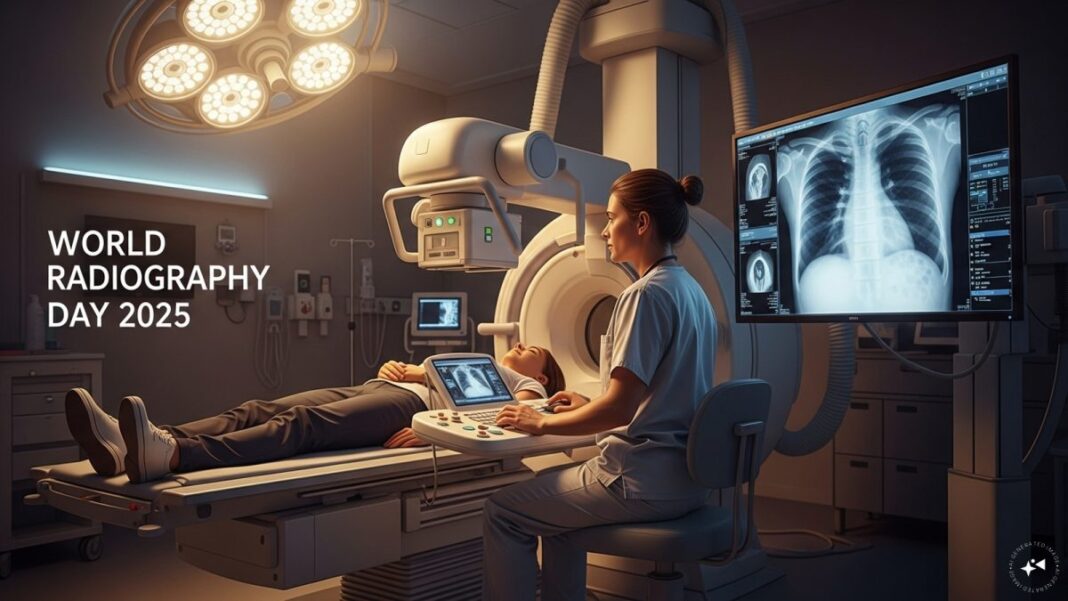Last Updated:
World Radiography Day celebrates X-rays and radiographers, highlighting medical imaging breakthroughs and AI advancements in modern diagnostics.
World Radiography Day is observed on November 8. (AI generated image)
World Radiography Day 2025: Every year, on November 8, the world observes World Radiography Day, a day that honours one of the greatest scientific discoveries in medical history: X-rays. This breakthrough changed the landscape of modern healthcare, enabling doctors to look inside the human body without surgery and diagnose countless medical conditions with greater accuracy.
The occasion also recognises the tireless efforts of radiographers and radiologists, the professionals who make this technology a vital part of everyday medicine. From diagnosing broken bones to detecting life-threatening diseases early, radiography plays an indispensable role in saving lives and advancing global healthcare.
World Radiography Day 2025: History
World Radiography Day marks the anniversary of Professor Wilhelm Conrad Roentgen’s discovery of X-rays on November 8, 1895, at the University of Wuerzburg in Germany. While experimenting with a cathode-ray tube, Roentgen noticed a mysterious glow that could pass through solid objects and illuminate photographic plates, an observation that would revolutionise science and medicine forever.
The medical community quickly realised the potential of this new form of radiation. Within weeks of Roentgen’s discovery, physicians across Europe and the United States began using X-rays to examine fractures and locate foreign objects inside the body. By 1896, X-rays were already being used on the battlefield to treat injured soldiers and John Hall-Edwards became the first surgeon to use X-rays during an operation.
To commemorate this life-changing innovation, the International Society of Radiographers and Radiological Technologists (ISRRT) officially declared November 8 as World Radiography Day in 2007, aligning the date with Roentgen’s groundbreaking discovery.
World Radiography Day 2025: Radiographers And Their Vital Role
Radiographers are the backbone of modern diagnostic medicine. They are highly trained professionals who operate complex imaging equipment and ensure that accurate images of the body’s internal structures are captured safely. These images enable doctors to identify fractures, tumors, infections and a wide range of diseases with remarkable precision.
They use advanced technologies such as X-rays, CT scans, MRIs, and ultrasounds to visualise bones, organs, tissues and blood vessels. Through these images, physicians can detect injuries, monitor disease progression and plan appropriate treatments.
Beyond diagnosis, radiographers also play a crucial role in radiation therapy, especially in the treatment of cancer. They carefully administer targeted doses of high-energy radiation to destroy cancerous cells while protecting healthy tissues, working closely with oncologists to personalize treatment plans.
Patient safety lies at the heart of radiographic practice. Radiographers are responsible for positioning patients correctly, minimising radiation exposure and maintaining strict hygiene protocols. They also ensure the smooth and safe operation of powerful equipment, particularly in MRI environments, where even minor safety lapses can have serious consequences.
Their combination of technical expertise and compassionate care makes radiographers essential to both patient wellbeing and medical precision.
World Radiography Day 2025: Advancements in Imaging Technology
Since Roentgen’s time, medical imaging has evolved beyond imagination. Continuous innovation has made imaging faster, safer and far more accurate than ever before.
The development of hybrid imaging technologies — such as PET/CT, PET/MRI and SPECT/CT represents a major leap forward. These techniques merge anatomical and functional imaging, allowing doctors to visualise both the structure and the biological activity of organs simultaneously.
For example, PET/CT scans are now indispensable in cancer diagnosis and treatment monitoring, revealing how tumors respond to therapy in real time.
Artificial Intelligence (AI) has ushered in a new era for radiology. AI-powered algorithms can analyse thousands of images in seconds, enhancing image quality, detecting early disease patterns and assisting doctors in making faster, more accurate diagnoses.
Moreover, Explainable AI (XAI) models in medical imaging provide transparency by showing clinicians how decisions are made, making the use of AI safer and more trustworthy in clinical environments.
World Radiography Day 2025: Health Impact of Radiology
Radiology has become an indispensable part of modern medicine, aiding in the early detection and treatment of countless diseases. Techniques like X-rays, CT scans, MRI scans, ultrasound and PET imaging have transformed the way doctors diagnose and treat patients.
However, with the growing use of ionising radiation in diagnostic tests, there are also health considerations to keep in mind. While radiological imaging is safe when performed correctly, repeated or unnecessary exposure to radiation can increase the risk of certain long-term health effects.
Humans are exposed to radiation from both natural and man-made sources. Natural sources include cosmic radiation, radon gas and naturally occurring radioactive materials in the earth. Man-made sources include medical imaging procedures and nuclear energy production.
Diagnostic tools such as X-rays and CT scans use ionising radiation, which in high doses or over prolonged exposure, can potentially increase the risk of developing cancer, genetic mutations and thyroid-related disorders. Sensitive groups such as children and pregnant women are more vulnerable due to their developing bodies.
Fortunately, with continuous technological advancement, modern imaging systems use significantly lower doses of radiation, while maintaining high-quality imaging standards.
Radiographers and radiologists follow strict safety guidelines to ensure patient protection, from using lead shields and limiting exposure time to monitoring radiation levels regularly.

Nibandh Vinod is a seasoned journalist with nearly three decades of experience, known for his in-depth coverage of events and festivals, as well as his expertise in SEO-driven content at News18.com. A tech-savv…Read More
Nibandh Vinod is a seasoned journalist with nearly three decades of experience, known for his in-depth coverage of events and festivals, as well as his expertise in SEO-driven content at News18.com. A tech-savv… Read More
November 08, 2025, 07:20 IST



